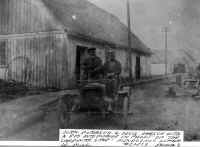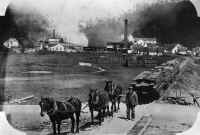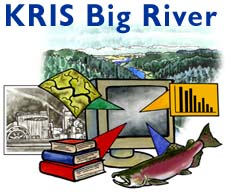Bibliography Background About KRIS
Big River History: People / Pioneers
All photographs provided courtesy of the Mendocino Historical Society and the Held Poage Memorial Home and Research Library, except where noted. Most are from the collection of Robert Lee. The Bancroft Library at U.C Berkeley also allowed use of a few select photos of the area from their Watkins collection. Further use of photos must be approved by the Mendocino Historical Society or the Bancroft Library. Click on image to see at full size.
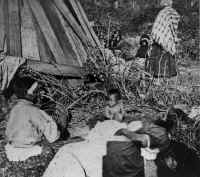 |
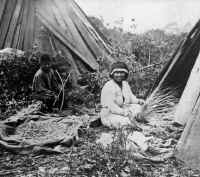 |
| View at Fury Town. Indian life in 1866 (169 KB) | Pomo woman working on basket at Fury Town Rancheria-1866. Note drying acorns (171 KB) |
April 5, 1852 Jerome B. Ford arrived in the bay on the schooner Fayaway, heading a party to ascertain the truth of stories relating to size and abundance of redwood trees. (It is uncertain if he was able to get to shore)
June 16, 1852 Jerome B. Ford and helper arrived at big river having come overland with work animals for the building of the first sawmill. (The Brig Ontario, with men and equipment, arrived 33 days later, having been slowed by strong winds)
June 18, 1852 Jerome B. Ford purchased the whole of the Point from William Kasten. (Today this land is known as the Mendocino Headlands. Here was built the first sawmill, where lumber was stored/shipped and freight and passengers arrived/departed)
July 19, 1852 Brig Ontario arrived. (It carried men and equipment to build the first sawmill with was located on the Point. Its lumber sawing capacity was rated at 50,000 feet per day. On the ship were Lansing, Kelly, Carlson, Williams and Crowley)
May 26, 1855 Jerome B. Ford worked at the Page mill, the Company's new, and second sawmill. (The plant was located at the eastern end of the flat, near the place where logs were removed from the river. New mill's daily cut, 60,000 feet)
October 1, 1874 Wilder Pullen injured while reconstructing the Little Northfork logging dam. (He was in charge of refurbishing the river's first such logging device which had been constructed during the Civil War period)
September 30, 1877 Henry Meiggs dies. (Founder of the Company, later escaped to South America when the business went into default. "Payments of debts should take precedence over payment of legacies" was written in his will)
March 5, 1879 The river rose to a height of 25 feet at James Nichols logging camp downriver from the foot of Big Hill. (his logging career was to include 3 logging camps, at Boyles, at Burkes tie camp and the one already mentioned)
May 6, 1885 Alfred R. Johnston granted a land patent for 160 acres of timberland on Dougherty Creek. (In his 20 years on the upper Southfork, he was to establish 7 known logging camps, built or operated 7 logging dams)
October 11, 1890 Logging contractor Alfred R. Johnston obtained timber land on the tributary upon which Horsetheif, or Al's big logging dam was constructed. (This logging device was the most distant from the mill, 48 miles)
September 17, 1902 Farewell reception held for the Jerome C. Fords. (they were leaving the community, having sold their, and other family members' interests in the Company. J.C. Ford was one of the first babies, third, born at Mendocino, the first boy)
Feb. 16, 1903 Martin M. Haxeltine died, a pioneer photographer. (His pictures are a source of information for historians interested in local history. He was a 40 year member of the Masonic order. A studio used by him still stands on Howard Street.)
June 7, 1903 Pepperwood Camp #756. Woodman of the World, WOW. Attended graveside services for H. C. Tanner at the Evergreen Cemetery. (The order had been instituted in July the preceding year with M. Garrison being the leading officer)
May 22, 1905 Logging contractor Alfred R. Johnston made his last timberland purchase on the river. (In his 20 years to this date on the river, he acquired nearly 8,000 acres, logging a great portion of them, then selling the property)
December 7, 1908 Carl Ludwig (Louie) Larsen became an American Citizen. (He was a millwright at the mill and emerged as an innovator, such as improving the jackscrew, log loader at the mill, the unique crane and monorail systems at the Point lumber yard.)
November 30, 1911 John Dougherty died. (Arrived in 1855, worked at the mill and later in the woods for Daniel Milliken. Dougherty later moved, and lived on the Southfork of Big River, hence the name of Dougherty Creek came into being)
Jan. 26, 1912 Andrew Burbeck drowned in the attempt to break up a log jam near Two Log Creek. (He and John Johnson had been sent out by the Company to do this work. The logs in this instance had only moved from log tiers placed 3 miles away)
September 24, 1912 Daniel Brewster Milliken died. (One of the earliest logging contractors. Built the first wagon road from town (Little Lake Rd), going down Big Hill to the river. Originally the road and hill was known as Milliken Road and hill.
January 4, 1913 Napoleon Bonaparte Bever died. (His photograph, the one showing a teamster moving lumber from the mill to the point, is frequently used. His fame is in hauling one million brick to the mill site for its unusual square chimney)
September 13, 1913 Recorded that William B. Burke, pioneer railroad tie maker, had retired. (He had worked for over 30 years on the river. In that period of time, had made over 1,000,000 railroad ties and an equal number of posts)
December 1, 1918 Harry Stuedman, former foreman of the Company's Lower ranch, died. (He had worked 14 years at the ranch, raising vegetables and fruit, notably apples, for the various logging camps. Grain was also raised to feed the working animals)
February 3, 1923 James Bowman tested out a new gasoline locomotive that was built at the mull by head mechanic Louis Larsen. (the machine with its Buick engine was tried out on the Flat and even climbed part way up the Incline while being tested.)
September 16, 1925 Charles B. Mallory received a gold watch from his workers. (Mallory had just retired from logging. His16 years on the river were unique in that he did not have a single death among his crews. He had 5 camps, built/operated 4 logging dams?
October 20, 1927 Former logging contractor David Brandon died. (He was also a railroad tie making contractor. A former County Supervisor, bullpuncher, mill operator. Had camps on both the Noyo and Big River. A gulch on each stream bears the name Brandon Gulch)
June 13, 1929 Alfred Ryerson Johnston died. (Logging contractor on the river for 34 years. Owned/sold nearly 8,000 acres of timberland. Established 14 logging camps and built or used 7 logging dams. Aided in designing the saw for felling the large virgin timber)
July 7, 1933 Robert David Swales Sr. died. (He had been the manager of the Company for 8 years. Prior to that task, had been employed by the parent company, the Union Lumber Company, and also their other subsidiary holdings)
August 22, 1935 Henry Flood died. (Arrived in 1872, began working as a hand logger, then became a well known bull-puncher. He advanced to the steam donkey and finally operated the giant yarders used in logging. Father of Hazel Flood, Leslie Flood and Nannie Escola)
Infrastructure - railroads, boats, bridges, etc.
Events - floods, storms, shipwrecks, etc
Logging / Mills - operations and events at mills, logging activities
Also see, Big River Was Dammed (excerpts) and Fish stories from the past
Photo: Napoleon Bever and horse team. See 1/4/13 excerpt.

